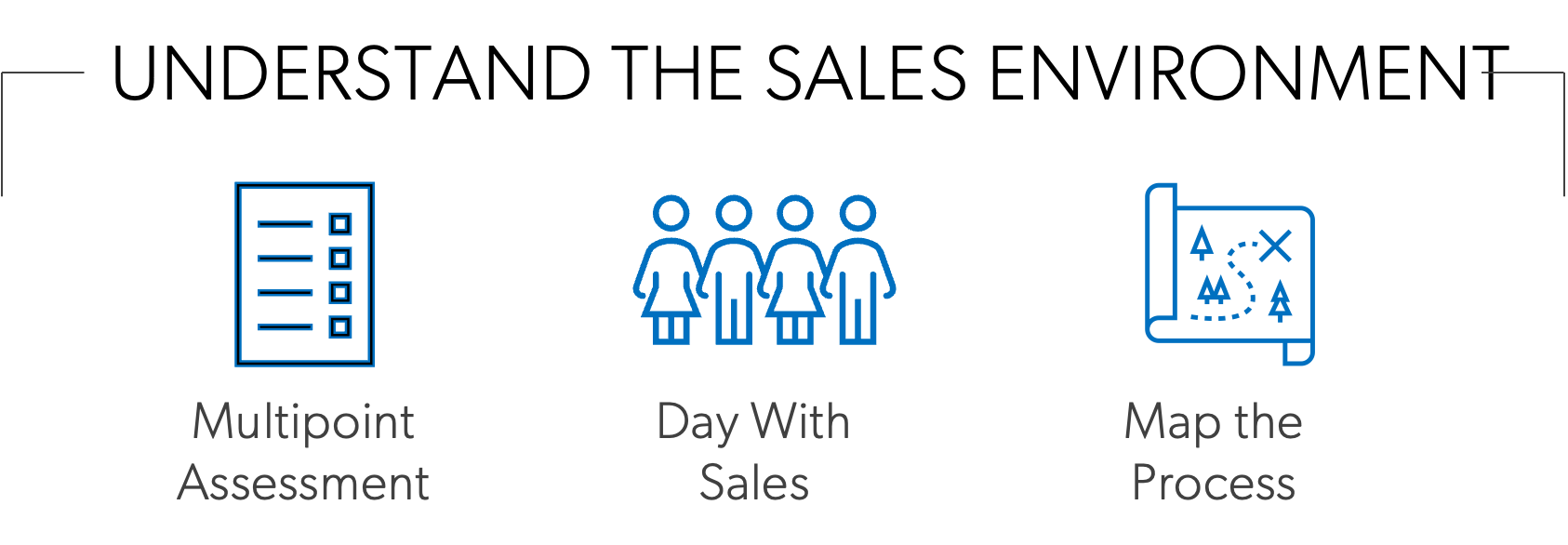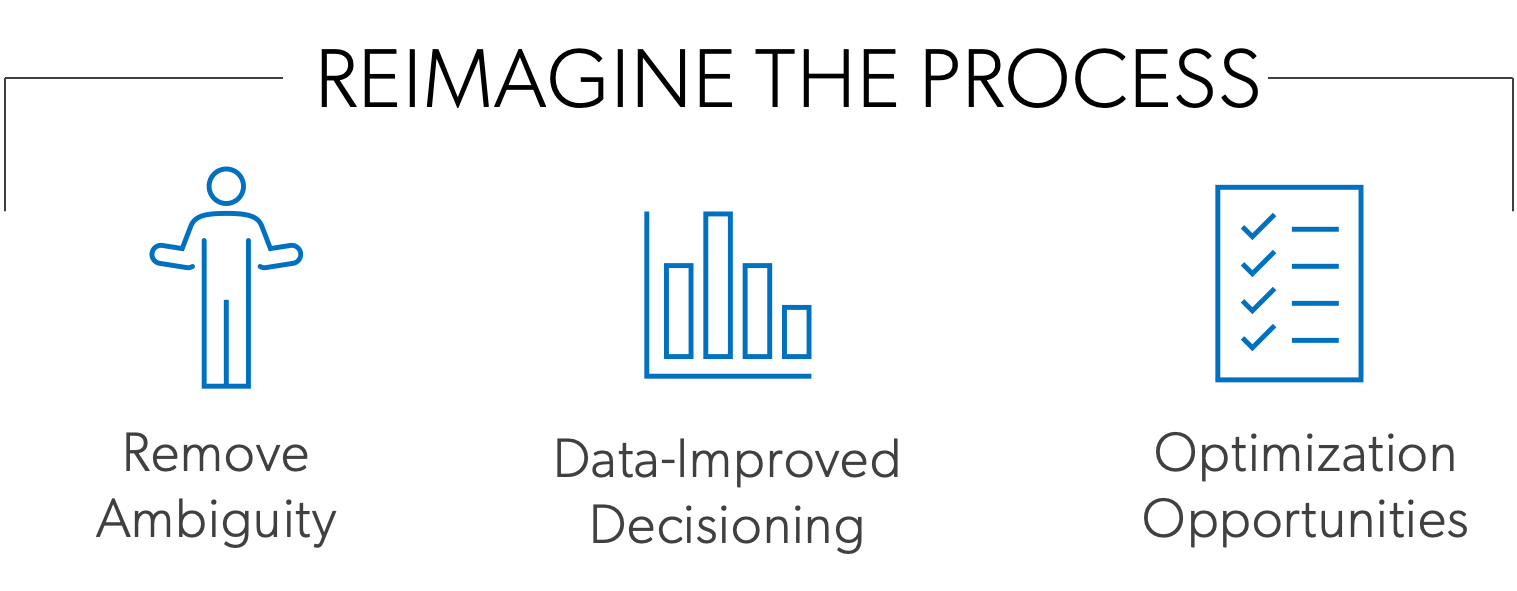HOW WE BUILD OPTIMIZED SALES PROCESSES FOR COMPANIES LIKE
[EXAMPLE COMPANY NAME GOES HERE]
We believe that a best-in-class sales process—approached deliberately and thoughtfully—can make the difference between a sales enterprise that is on cruise control and one that is screaming down the Autostrada.
Companies that outsource to MarketSource are looking for sales results. Our clients count on us to deliver for them in ways they can’t accomplish on their own. We are a professional sales organization and delivering sales results for our clients is all we do.
To achieve our client’s sales objectives, we start by understanding the company’s sales approach, then reimagine it in a way that optimizes its strengths, eliminates gaps and improves on inefficiencies. The outcome is a highly refined, custom sales process that empowers our sellers to be most effective and achieve the client’s goals.
How do we get there?

Get the Big Picture, Dive Deep
To build a highly refined sales process, we start with the big picture, then go deep. We begin with a thorough understanding of the existing sales environment—value proposition, sales velocity factors, channel partner business proposition, go-to-market and route-to-market strategies, tech stack, and much more.
We conduct a multipoint assessment to give us a comprehensive look at a wide range of business issues, from the competitive outlook and desired market share to brand value, buying personas, and success measures. We look at the dynamics of the client’s target market, personas, average deal size, new business pitches, and metrics.

We spend a day with our clients and their sales team to see how they work. We sit side-by-side with them, and observe each action the salesperson makes, step-by-step and touch-by-touch, from the moment they begin their day. How do sellers prioritize their work? What data do they rely upon and in what form do they receive it? How does the seller interact with their sales technology? What information do they access? What information do they input? Where are the information hand-offs? Are there gaps?
We document our learnings and chart every step to achieve a thorough map of the entire sales process, end to end.
Seeing the Process Through a Different Lens
Now we reimagine it. Once we have fully documented the existing sales process, we look at it through the MarketSource lens, a perspective based on our years of experience and success designing sales processes for the world’s most iconic B2B brands.
The MarketSource team consists of a range of seasoned experts with competencies in sales strategy, business process engineering, sales operations, sales technology, instructional design, and sales training. We assemble a dedicated team of specialists who comb through the learnings and the current-state process map and evaluate every piece.
The team looks for places where decision-making can be improved through data and technology. We identify ineffective or inefficient hand-offs and steps that are bumpy or ill-defined. One of our particular interests is determining the role technology plays: Is the technology working for the seller, or is the seller working for the technology? Where are the hand-offs? Where are the gaps?
We look for ways to increase “green time” and reduce “red time.” Green time is when a seller is actually selling, and red time is administrative work—data entry, reporting, researching. While there is always red time in a seller’s day, our goal is to reduce it to a minimum so that sellers spend most of their time in the green zone.

We identify areas of opportunity to streamline and improve the sales process. For example:
Remove ambiguity. We like a clear path. To make our sellers as effective and efficient as possible, we seek to remove as much ambiguity from the workflow as possible. This includes ordering our sellers’ workdays, ensuring consistent next steps, and making handoffs seamless and productive.
Identify where data can improve decision making. We are data driven. We know that having sales reps working with the right data can inform—and ultimately transform—the sales process. (More on this below.)
Clear the way for optimization. We aim for zero waste. To increase green time and decrease red time, we eliminate redundancy and focus only on what helps our sellers. This comes into play later as we develop and customize the sales tech stack for each client, and require that only essential information be recorded and reported.
Optimized Process Design
To this point, we’ve been in information-gathering mode— observing, evaluating, discussing, brainstorming. Now we begin the design-and-build stage.
Comprehensive process map. In this phase, our team takes everything we’ve learned about the client’s specific needs and creates the most effective sales process, with each step built into the system to make it visible and measurable. We map out every step. Whiteboard it. Document it.
Role-based process maps. Each role on a sales team is different and each requires its own defined workflow, so we take a role-based approach. The purpose is to guide and lead the salesperson through each step they need to perform to reach their goals and objectives. And because the process is measurable, when we make changes, we are able to see if we achieved the desired improvements.
The process maps document each role’s primary activities and the flow of those activities throughout the day such as the number of connects per rep per day, number of touches and quality conversations, and more. We ask questions and document our answers. What information does the salesperson need at each step? How long should it take to complete each step? How do we measure success?

Data Drives Everything
Our modeling tells us exactly what it will take to make each salesperson in each role successful. For example, we can reverse engineer the activities and timing necessary to reach the client’s revenue goals. How many calls does a sales rep need to make to get a demo scheduled? How many outreaches are required to make to get a decision maker on the phone? We know these answers.
However, success relies on good data. If the data isn’t accurate, sales efforts stall. Without good data, a salesperson might be trying to contact people who are no longer at the company or have switched jobs and tracking down new contact information is the epitome of red time.
Data drives our highly coordinated sales plans. Our sellers don’t just call prospects alphabetically or only accounts that have purchased in the past. Rather, we develop customer scoring models to determine which accounts have the highest growth potential and are most likely to deliver results. While other sales organizations might tier their prospects based on past performance, our scores are based on revenue potential.
We look at revenue growth rates, new accounts, revenue frequency, and more to create a scorecard for each customer. We examine overall spend relative to how much our client is getting from that customer to determine where we can gain share of wallet. Each account is assigned to a matrix where we can see potential based on growth and revenue parameters. Where prospects fit in the matrix drives how our approach to sales outreach, touchpoints, and cadence.
With each client, we define KPIs, tracking metrics, and reporting requirements. We develop reporting dashboards to regularly monitor performance and for review with our client at an established cadence.
Even training is impacted by data. When we launch a new sales team or bring in a new seller, they have an up-to-the-minute playbook. We work through every step in the sales process, every handoff, every document, and every piece of technology they’ll use. We create a digital playbook that walks them through each part of the process.
A Culture of Improvement: Relentless Incrementalism
Even the most well-designed process can be improved, and from the moment a program is launched, we look for opportunities for improvement. Because even small improvements in one area yield exponential improvements across the organization.
We call this
Relentless Incrementalism™
This is what top performers seek. Consider Roger Banister, who broke the 4-minute mile—a feat considered beyond human achievement—by just 6/10ths of a second in 1954. After that, more runners beat Bannister’s time, a few tenths of a second at a time. Small improvements changed the game.
In our world, we value improvements big and small. We revisit the process model and confirm that the salespeople are following it—or, if not, why not? Where are the breakdowns? What do we need to fix? Can we improve the design of a call report? Reformat a CRM screen for greater efficiency?
We believe that even the best salespeople can get a little bit better, so our teams are always sharpening their skills and getting ongoing coaching from their managers. For example, sales calls are recorded, and we ask our salespeople to choose their best and worst calls every week to discuss with their managers. We ask each salesperson to identify something to work on for the next month or two and document the impact. This type of skill-building is simply part of how we work.
For us, improvement is not an event or a point in time. It is a continuous process that every MarketSource leader thinks about every single week so that we can improve the delivery of our services to create more value for our customers and our employees.
Maximizing Our Clients’ ROI
It’s taken us years to develop this highly sophisticated approach to sales process. It may seem like a lot of work to get our programs launched—and it is.
But in its thoroughness and flexibility, our practice can accommodate every sales scenario. It’s why we are able to tackle the most difficult and complicated programs for our long-term clients. We are dogged about it for one reason: it works.
Building A Kick-A$$ Tech Stack
Buying sales tech is easy. Integrating it into the sales workflow requires enormous effort. For us, sales technology is not merely an enabler, but a foundation—it’s an integral part of our effectiveness, efficiency, and optimization.
At MarketSource, we build our sales process into our tech stack. We start with our business process engineers, who model a day for each sales role and build that model into Salesforce. We eliminate all the extraneous screens and tasks and include only the essentials. This way, the CRM leads the sales rep through each action with no wasted time or effort. The CRM works for the sales rep, not the other way around.
This is true for every sales role—each role has its own process map and the CRM guides them to the next step as quickly and efficiently as possible. This drives adoption and reduces red time.
For more on Building a Kick-A$$ Tech Stack, read the blog >>
WANT MORE SALES?
If you’re looking for a managed sales partner that takes a deliberate and thoughtful approach to achieve its clients’ goals, let us show you how we can design a best-in-class sales process for [example company name goes here] that optimizes its strengths, eliminates gaps, and improves on inefficiencies.
What are you waiting for?
